- Agentic Ai
- 2025-07-25
Your Complete Guide to Agentic AI: From Core to Application

Audio Track
Table of Contents
Key Takeaways:
- Agentic AI goes beyond task automation; it makes independent decisions, learns from interactions, and adapts to a dynamic environment.
- Agentic AI combines memory, decision logic, and feedback loops, following human-like reasoning and long-term planning.
- The agentic system is transforming industries like retail, insurance, healthcare, finance, government, and more by improving personalization and efficiency.
What is Agentic AI?
An Artificial Intelligence system, Agentic AI, can achieve particular goals with limited supervision. It acts autonomously, conforms in real-time, and solves multi-stage problems based on objectives.
Agentic AI goes beyond task implementation; it interprets situations, evaluates possible options, and adjusts its approach to reach a desired outcome.
This advanced technology plans, acts, learns, and improves. An AI system can:
- Make decisions based on context and adapt to changing conditions in real-time.
- Classifies goals into sub-tasks and meets them independently.
- Adopts tools and other AI systems to fetch results.
- Adapts over time to deliver better results.
According to research, about 33% of enterprise software apps will involve Agentic AI by the year 2028, enabling nearly 15% of each day’s work decisions.
These intelligent agents are goal-driven, leveraging AI techniques to complete a task and accomplish goals. These agents work without explicit input and don’t require predetermined outputs.
Agentic AI vs. Traditional AI Systems
AI has gained immense popularity over the past decade, and we cannot think of working without its capabilities. From recommendation engines to virtual assistants, it’s absolutely hard to imagine functioning without their support. However, not all AI is built the same, and this is exactly where Agentic AI stands apart from traditional AI systems.
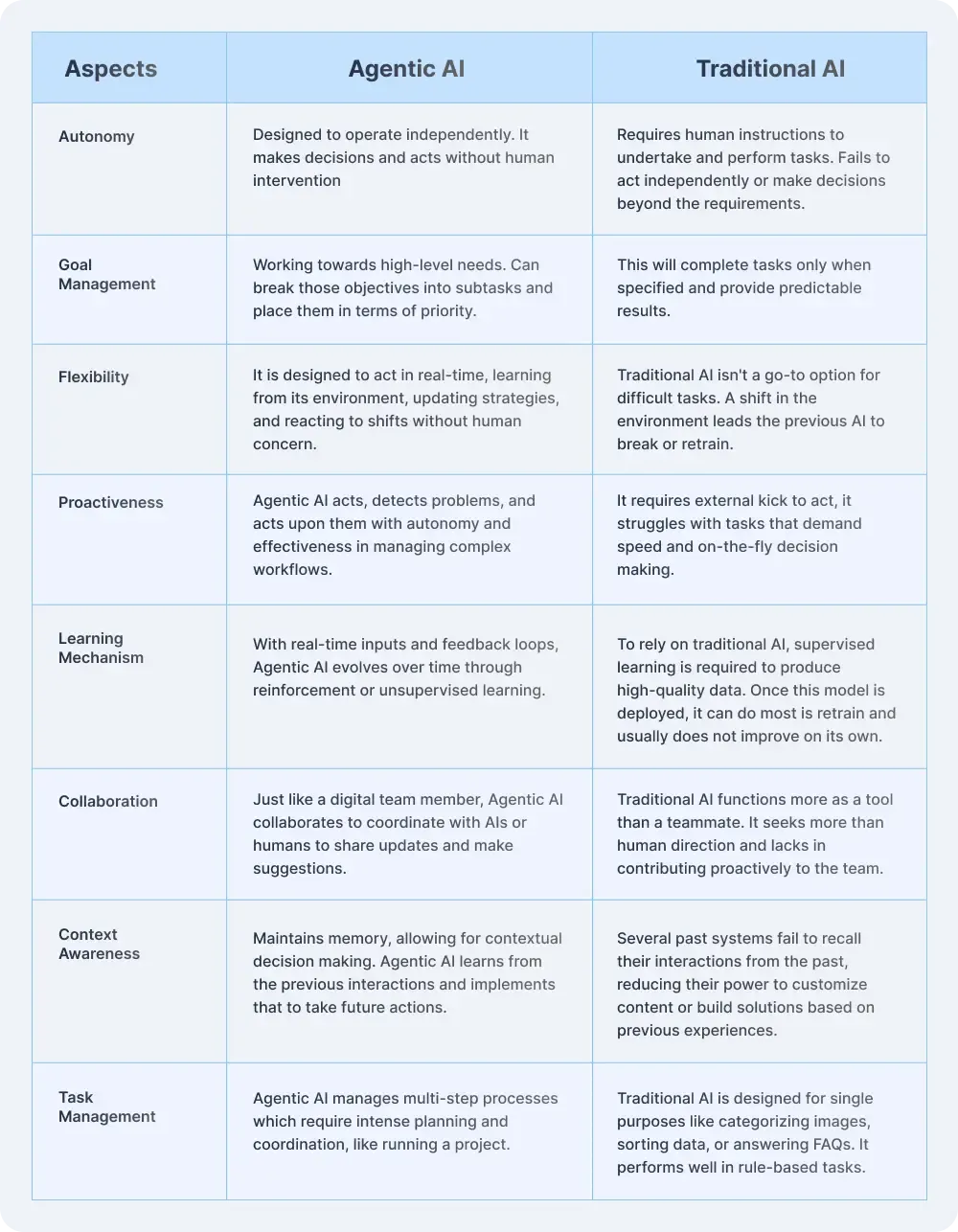
How Agentic AI Works?
By now, we know that the goal of Agentic AI is to help businesses operate independently, using advanced technologies and smart methods. It analyzes real-time data, learns, and adjusts strategies to deliver top-notch solutions. Moreover, several AI agents can collaborate, exchange information, and boost decision-making.
Agentic AI enhances its problem-solving abilities by taking into consideration several Large language Models (LLMs) and cross-referencing insights.
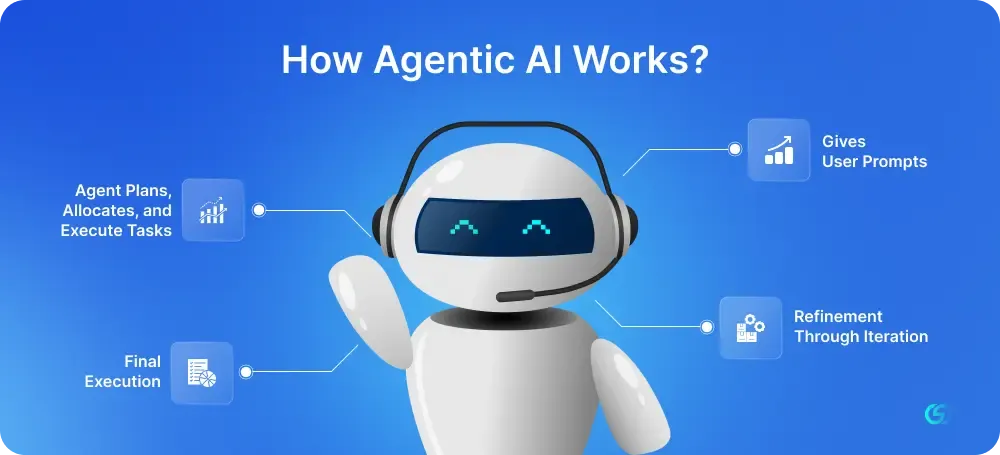
Agentic AI systems thrive in evolving environments by continuously adjusting to real-time user feedback through reinforcement learning. By continuously learning and adapting their approach, AI agents maintain high performance even in unpredictable and complex settings.
Another key aspect of AI agent operation is machine learning, where they learn from data and patterns to make predictions. These systems refine decision-making by browsing through vast amounts of data. This continuous learning tackles a wide range of challenges, allowing them to handle complicated scenarios.
Agentic AI takes a few logical steps to solve complex challenges and reach goals. Let’s see how it works:
➡ Gives User Prompts
The user interacts with AI with the help of natural language prompts, similar to speaking to a trusted AI assistant. The system interprets the intent and seeks further clarification if required.
➡ Agent Plans, Allocates, and Executes Tasks
The AI system converts the prompt into a structured workflow, breaking it down into tasks and subtasks. A managing agent coordinates these tasks with specialized subagents. These subagents are equipped with domain knowledge, proper tools, and organizational data to carry out the assignment.
➡ Refinement Through Iteration
During the process, the agent may check in with the user for feedback and clarification. The system refines the output through multiple iterations based on the input provided to align with the user’s expectations.
➡ Final Execution
Once the solution is ready, the agent takes the final steps needed to fully complete the task the user requests.
Benefits of Using Agentic AI
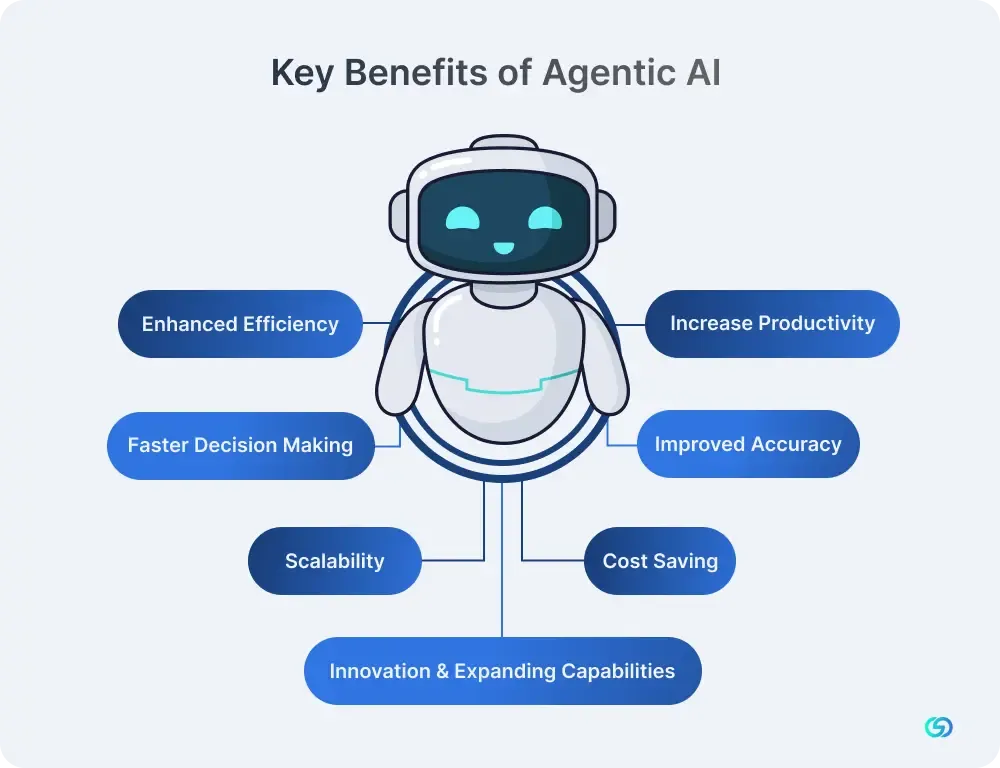
Agentic AI promises to be transformative for organizations, bringing a host of benefits to streamline operations, enhance decision-making, and improve efficiency.
🔹 Enhanced Efficiency
Agentic AI can carry out complex workflows autonomously that would typically require human involvement for coordination across departments and tools. This transition reduces manual effort and decreases cycles in various domains like sales operations, DevSecOps, and RPA.
🔹 Increase Productivity
Agentic AI will be widely adopted in enterprises to significantly increase productivity by automating repetitive tasks (taking over mundane and time-consuming jobs), streamlining workflows, and autonomous decision-making. This allows human employees to focus on high-value tasks and strategies.
🔹 Faster Decision Making
Business decisions once took hours or even days for humans to make. However, with the advent of Agentic AI, real-time decision-making became crucial, responding to market demands faster. For example, interpreting and responding to a cyber threat instantly, fixing bottlenecks as they arise, or capitalizing on market opportunities.
🔹 Scalability
One of the best advantages of Agentic AI is that it can manage several goals, expanding operational capacity without the need to hire more employees. This is effective in areas like customer service.
🔹 Improved Accuracy
We know that automation reduces human errors, but Agentic AI takes it even further by judiciously handling complicated tasks with much precision. Nonetheless, these agents can enforce compliance rules. In industries like healthcare, finance, and logistics, this accuracy is quite crucial, leading to fewer errors and misdiagnoses.
🔹 Cost Saving
Agentic AI offers cost savings through automation and optimization across various business functions, including marketing, customer support, sales, and operations, resulting in reduced labor costs, increased efficiency, and improved resource allocation.
🔹 Innovation & Expanding Capabilities
With Agentic AI, companies can redesign operations and processes innovatively. Technology does things faster, allowing for new workflows. In areas like reinforcement learning, memory-based reasoning, and multi-agent collaboration, witness innovation, pushing the boundaries and capabilities of what these intelligent systems can do. Agentic AI is expanding its role, and as these systems mature, they open doors to more evolving applications across industries, transforming the way we work, decide, and innovate.
Key Characteristics of Agentic AI
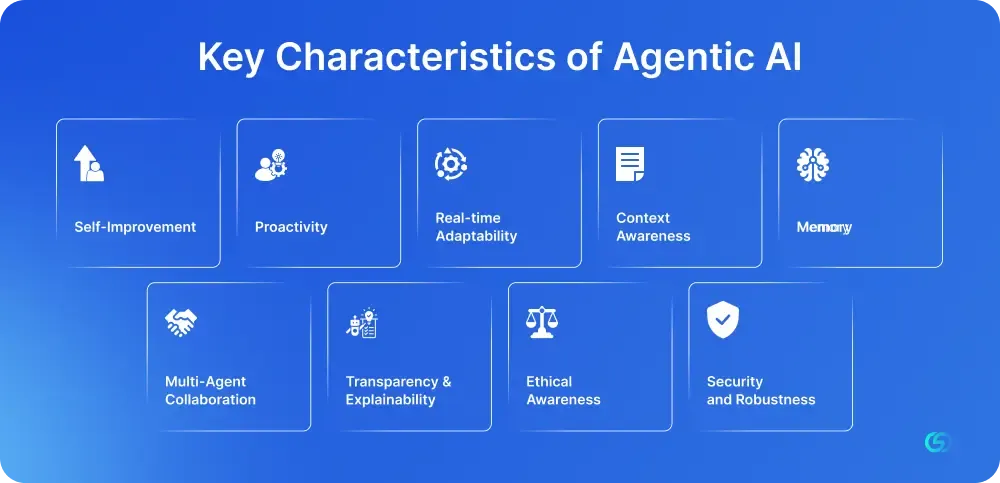
So, what exactly does Agentic AI do that makes such a big deal? It's not only limited to following instructions, but a system that acts like a real assistant and knows how to get things done. Agentic AI brings intelligence and flexibility that is unmatched by traditional AI. Let’s take a closer look at its capabilities:
This makes the Agentic AI system well-suited to organizational challenges that require flexibility. Here are some key characteristics of Agentic AI that show up in practice:
💠 Self-Improvement
Agentic AI has the potential to refine its strategies continuously and make smart decisions based on the feedback from its interactions and outputs. This is essential for maneuvering environments where conditions can change quickly.
💠 Proactivity
Agentic AI, unlike reactive systems, initiates actions. It determines the needs, finds opportunities, and avoids risks by taking a step before being asked. This includes tracking and interpreting signals, initiating workflows or escalations, and recommending steps before the event occurs.
💠 Real-time Adaptability
Agentic AI can learn and adjust with user interactions to achieve certain objectives without human intervention. This is a key difference between traditional AI and Agentic AI. The latter leverages techniques like deep learning to enhance strategies and performance as it interacts with its surroundings.
💠 Context Awareness
When it comes to Agentic AI, context is crucial. Whether monitoring external data, user interactions, or continuous real-world data, it adapts and adjusts its responses to be effectively applied in real-world scenarios. For instance, AI-driven medical assistants can analyze patient symptoms with the help of their medical history, genetic factors, and lifestyle, resulting in a more accurate diagnosis.
💠 Memory
Memory in Agentic AI stands for its ability to store, retrieve, and update context to improve performance. This helps in personalization, building on previous interactions, and informing future actions.
💠 Multi-Agent Collaboration
These characteristics refer to a pattern in which several autonomous agents, each with a different role, objective, and specialization, work together to solve complicated tasks. These agents operate independently or with another agent by sharing details, delegating responsibilities, and optimizing workflows collectively.
💠 Transparency & Explainability
In Agentic AI, this is a developing area. An important characteristic for building trust is the ability to understand the reasoning behind the agent’s decisions and actions.
💠 Ethical Awareness
Being designed with built-in ethical frameworks, Agentic AI systems help ensure that their decisions align with societal norms and human values. This includes features for bias detection, fairness, and conveying privacy concerns.
💠 Security and Robustness
When an Agentic AI acts on its own, you want to be sure that they are safe and trustworthy. This is exactly where security and robustness come in. Agentic AI is designed to operate in unpredictable environments without making risky decisions or breaking down. It’s built with safeguards that help it stay on track.
Capabilities of Agentic AI
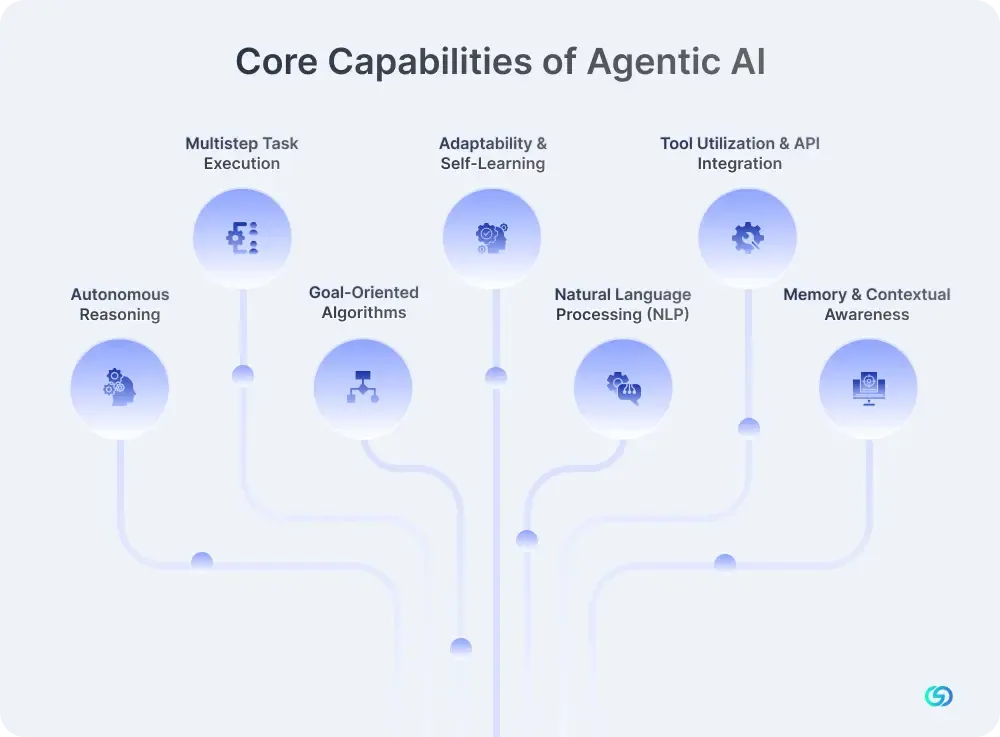
So, what exactly does Agentic AI do that makes such a big deal? It's not only limited to following instructions but a system that acts like a real assistant and knows how to get things done. Agentic AI brings intelligence and flexibility that is unmatchable to traditional AI. Let’s take a closer look at its capabilities:
1. Autonomous Reasoning
One of the key traits of Agentic AI is its ability to act independently. Traditional systems used to rely on predefined rules and constant human input; agentic systems monitor the situation and weigh different options to choose the best. Autonomous reasoning helps the AI to adapt to unexpected challenges, tackle complex problems, and make decisions that align with goals without requiring step-by-step instructions.
2. Multistep Task Execution
Agentic AI manages the entire workflow, right from goal-oriented behavior, autonomy, reasoning, problem-solving, and multi-step planning. These characteristics allow Agentic AI systems to function independently, make informed decisions, and adjust their actions to achieve complicated objectives without human intervention.
3. Goal-Oriented Algorithms
Agentic AI systems are specialized to work toward particular goals, helping make autonomous decisions. Unlike traditional AI systems that follow pre-programmed instructions, Agentic AI can define its own course of action, modify to change circumstances, and collaborate with humans or other AI systems to achieve complex tasks.
4. Adaptability & Self-Learning
At the core of the Agentic AI platform, self-learning enables the system to evolve and respond to new data or scenarios. Powered by machine learning algorithms and datasets, this capability drives adaptability. Self-learning mirrors human problem-solving, allowing Agentic AI to handle complex workflows with minimal intervention.
5. Natural Language Processing (NLP)
One of the top capabilities of Agentic AI is Natural Language Processing (NLP), meaning it can understand and respond to human language. It can interpret and act just like a real assistant would, using NLP and Natural Language Understanding (NLU).
6. Tool Utilization & API Integration
Agentic AI has the capability to interact with external systems like APIs and databases to perform tasks and gather information. This integration enables it to book meetings, update CRM records, fetch reports, or even trigger workflows without any manual input. It functions like an intelligent, connected teammate that knows how to get things done across platforms.
7. Memory & Contextual Awareness
Agentic AI has the ability to memorize context and learn through previous interactions and fetch memories. This further allows for personalized responses.
Agentic AI Must-Have Feature
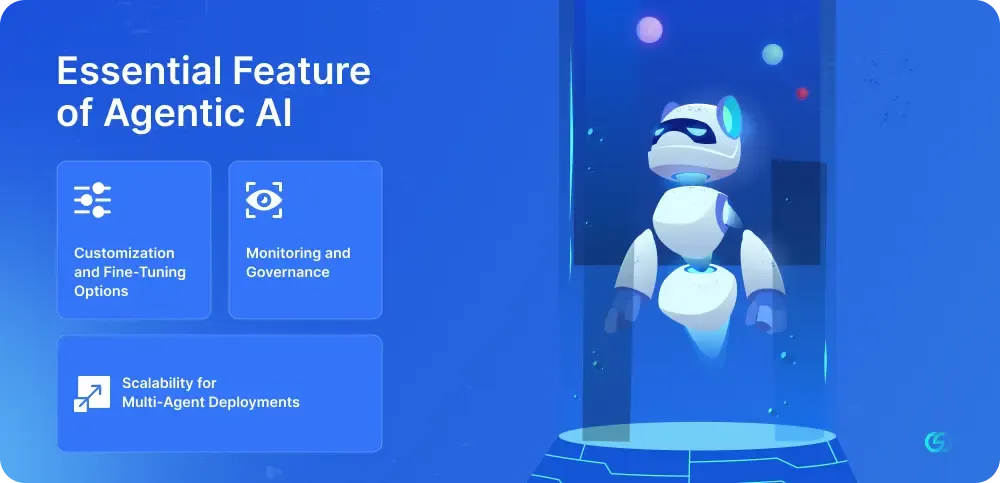
What makes Agentic AI stand out is its autonomy and some of the excellent features, as follows:
Customization and Fine-Tuning Options
To be able to customize and fine-tune Agentic AI platforms is quite essential to align implementations with particular business needs. Customization flexibility ensures AI agents work optimally, delivering increased value. Businesses should find it easier to adjust to parameters and incorporate rules into the AI framework. With customization, you can enhance efficiency and ensure compliance.
Monitoring and Governance
For Agentic AI, monitoring and governance are critical components. The system is designed to operate with autonomy, but it is essential to ensure that its actions align with business goals and ethical standards. With continuous monitoring, businesses can track AI agents’ activities and decisions in real-time, offering visibility into how agents make decisions.
Governance tools offer a framework for Agentic AI to work responsibly, covering policy definition, decision-making guidelines, and accountability systems. These tools ensure compliance with standards and regulations.
Scalability for Multi-Agent Deployments
The power of Agentic AI lies in its capacity to grow with multi-agent deployment, allowing businesses to manage difficult workflows easily. The system operates with multiple autonomous agents, each controlling a specific job while also connecting to achieve broader objectives.
Applications of Agentic AI
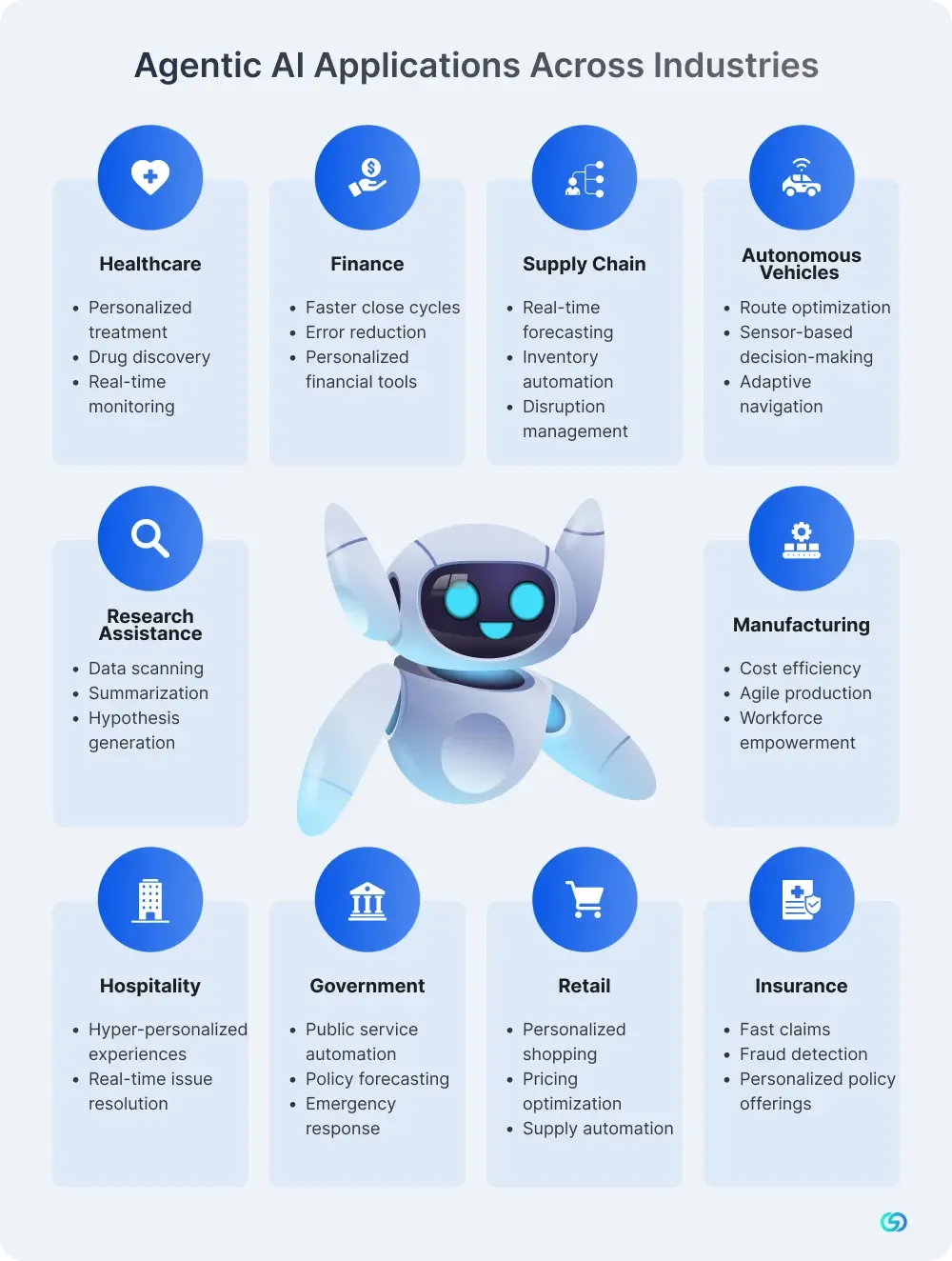
By now, you know how versatile Agentic AI is, which has led to its adoption across diverse industries, showcasing its power to modify workflows and processes of decision-making. Let’s explore how the application of Agentic AI systems in various industries is driving innovation.
1️⃣ Healthcare
Agentic AI is the biggest untapped opportunity in healthcare right now. The healthcare industry is costly, complex, and always evolving, but now with the new wave of autonomous AI, reasoning and planning have become more convenient. Agentic AI in healthcare personalizes treatment by
- Monitoring patient-specific data
- Enhancing drug discovery with the help of advanced simulations
- Helping with medical referrals and diagnoses by analyzing charts and recommending treatments
- Serving as a virtual assistant that provides real-time monitoring, along with appointments and medication reminders
[Other Useful Resource: Agentic AI in Healthcare: How Is It Transforming the Industry?]
2️⃣ Finance
Studies show only 58% of companies have incorporated autonomous AI agents into their finance operations. Companies leveraging Agentic AI in finance show over 40% faster close cycles and reduce reconciliation errors by 95%. The system transforms financial services in several ways, such as:
- Driving innovation, creation of new financial tools
- Enhancing customer interactions with highly personalized agents
- Streamlining operations, reducing human errors
3️⃣ Supply Chain Management
The Agentic AI application in supply chain management is expected to grow at a CAGR of 38.8% from 2024 to 2030, reaching over $40 billion. Companies leveraging Agentic AI in logistics are transforming supply chains by:
- Automating demand forecasting using historical data in real-time
- Adjusting inventory levels across locations
- Coordinating with vendors and partners without manual input
- Proactively resolving delays and disruptions by adapting routing
4️⃣ Autonomous Vehicle
Agentic AI is the brain behind autonomous vehicles, allowing real-time smart decision-making in complex environments like parking areas, urban traffic, and highways. Unlike traditional AI, these AI agents adapt to new scenarios, ensuring smoother rides, allowing for:
- Better route optimization based on traffic, weather, and road conditions
- Faster decision-making by analyzing real-time data from various sensors
5️⃣ Research Assistance
Agentic AI in research assistance is helping rapidly reshape how research is conducted across industries. Those using agentic systems for research report faster turnaround times and lower manual effort. These AI agents help:
- Scan large datasets and extract relevant insights in minutes
- Summarize complex academic or market research papers
- Generate hypotheses based on emerging patterns
- Citing sources and findings in a structured format
6️⃣ Manufacturing Automation
Creating stand out products is the beginning. With Agentic AI, businesses can streamline manufacturing processes to drive growth, improve experience, and minimize risks. Here’s why you can tap into the potential of powerful automation processes:
- Significant cost reduction
- Dramatic efficiency gains
- High-quality product
- Unmatched flexibility and agility
- Empowered workforce
7️⃣ Hospitality
The travel and hospitality industry, embracing Agentic AI, is experiencing substantial benefits across key areas. This helps travel businesses optimize operations and deliver enhanced customer service.
- Hyper-personalized travel experiences
- Real-time problem solving
- Revenue optimization
- Resource management
8️⃣ Government Entities
Agentic AI is transforming how government entities operate and is expected to grow significantly in the coming years. These systems are changing workflows, improving service delivery, and supporting data-driven policymaking.
- Streamline public services
- Crisis response and emergency management
- Regulatory compliance and monitoring
- Policy simulation and forecasting
9️⃣ Retail Industry
Agentic AI’s unique capabilities are transforming the retail industry to boost customer experience and accelerate growth. It presents an opportunity for brands to stay competitive in a rapidly evolving market. Modern retailers have adopted Agentic AI to:
- Deliver hyper-personalized experiences
- Automate inventory and supply chain decisions
- Enhance in-store and online engagement
- Optimize merchandising and pricing strategies
🔟 Insurance Industry
In an industry that requires efficient customer service and risk management, Agentic AI offers insurers an opportunity to modernize how they operate on a scale. By using AI agents, insurance providers can:
- Speed up claims processing
- Personalize offerings
- Improve risk assessment
- Strengthen fraud detection
- Enhance customer support
Key Components of Agentic AI
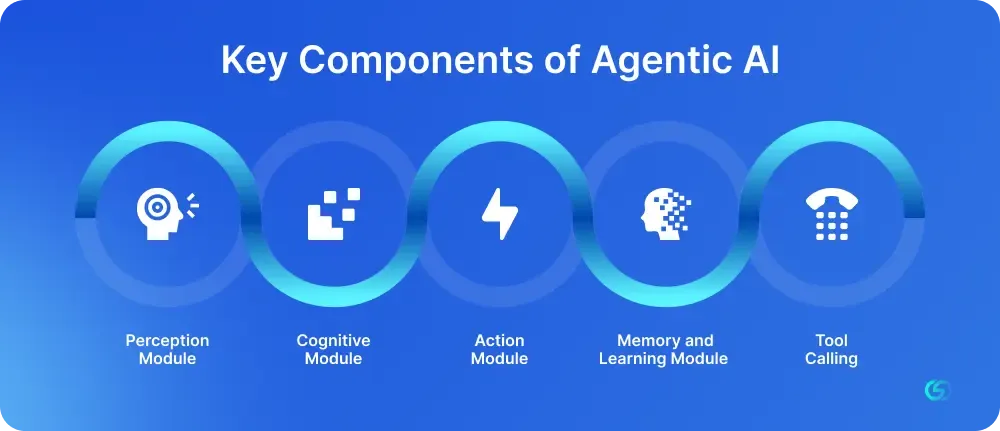
Developing an effective AI system means more than selecting the right model—it means structuring a modular system where each component has a role to play. Read how Agentic AI works. We have broken down into its key components:
◼ Perception Module
Just as the name suggests, the perception module is how an agent interprets and “sees” its environment. From processing audio, text, to visuals, this component module transforms raw data into structured information. In many systems, advanced computer vision is required to interpret videos and images. While in others, NLP or sensor data analysis is crucial. The accuracy of this perception module affects autonomous decision-making.
◼ Cognitive Module
After the agent interprets the environment, it moves to a decision-making engine, which is responsible for reasoning, planning, and focusing on actions. It serves as the “brain,” responsible for defining goals based on the perceived data and the defined objectives.
◼ Action Module
It is responsible for carrying out decisions made by the agent, including interacting with a UI, calling APIs, and controlling devices in IoT. Action modules need to be designed for security and flexibility, especially when system permission or credential management is involved. Actions can involve interacting with third-party tools in a highly integrated environment.
◼ Memory and Learning Module
The memory and learning modules store past experiences and outcomes, so you don’t have to start from scratch, recognize patterns, and make refinements over time. This module supports personalization, adaptability, and performance. It also plays a key role in workflow optimization, allowing agents to recall previous interactions, eliminate repetitive processes, and minimize redundancy throughout the process.
◼ Tool Calling
An agentic AI workflow may require access to external tools to finish off tasks. This mechanism is where agents induce external tools, APIs, or functions to extend their capacity beyond their native reasoning and knowledge. This helps AI to act, gather real-time data, and communicate with external systems.
Tools & Frameworks for Agentic AI Development
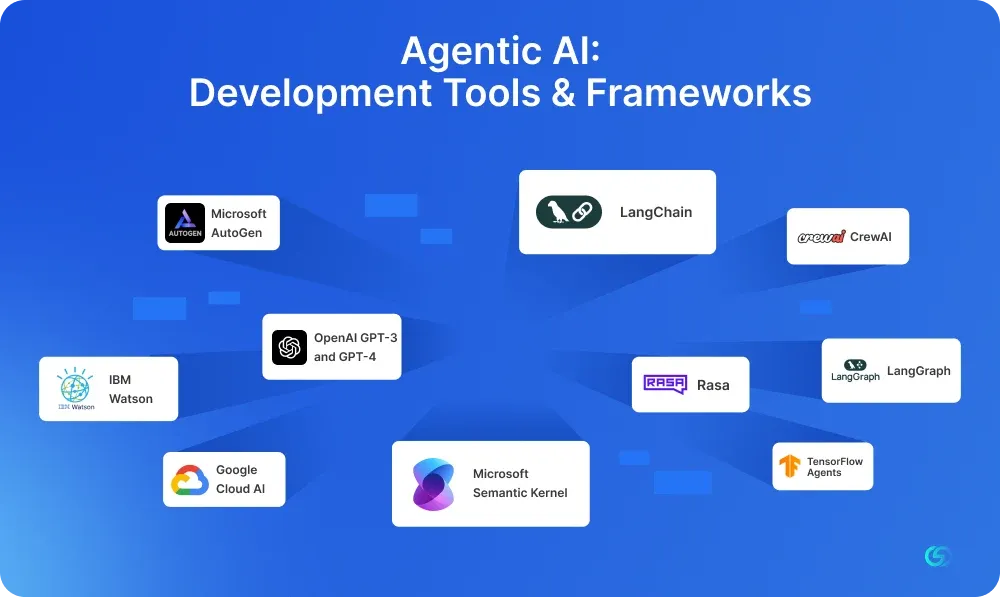
Ready to explore some of the top Agentic AI development tools and frameworks? These can help you build autonomous systems that can help you learn and make crucial decisions.
Microsoft AutoGen
Want to get up and running with Agentic AI quickly? Microsoft AutoGen is a great option for businesses that helps automate tasks and streamline decision-making processes with less technical knowledge.
Pros:
- Convenient to use and deploy without coding
- The Microsoft ecosystem can integrate well
- Best suited for small to medium application
Cons:
- Unsuitable for complex solutions
- Limited adaptability of modern AI use cases
- Best fit for simpler tasks
LangChain
A robust framework for building apps that need strong NLP. LangChain is great for building agents that can process text, which makes it a go-to virtual assistant and chatbots.
Pros:
- Highly flexible and customizable
- Extensive open-source community
- Best for advanced NLP tasks
Cons:
- Requires expertise in coding
- Can be daunting for simpler tasks
- Complex for smaller projects
CrewAI
CrewAI is quite easy to approach for users who come from a non-technical background and are not familiar with coding. This open-source framework is a great choice for anyone looking to design a simple AI agent.
Pros:
- User-oriented, no coding required
- Quick to implement
- Tailored for small business needs
Cons:**
- Limited functionality scope for large projects
- Lack of modern features for complex tasks
- Inflexible for highly customized solutions
LangGraph
Combining graph-based data structures and the power of language models, LangGraph is a great fit for applications that deal with complex relationships across data sets.
Pros:
- Perfect for complex data relationships
- Built to handle large-scale data-driven tasks
- Applicable for a diverse range of industries
Cons:
- Requires extensive knowledge of AI concepts
- Complex to learn for first-time users
- Difficult for simpler applications
Microsoft Semantic Kernel
The Microsoft Semantic Kernel helps AI agents determine the next step based on context. It offers an excellent way to interact with systems and users by understanding the data.
Pros:
- Best for understanding context in data
- Smooth integration with Microsoft tools
- Scalable for complex and large applications
Cons:
- Best-fit businesses leveraging Microsoft products
- Rigid outside Microsoft’s ecosystem
- Needs familiarity with Microsoft tools
OpenAI GPT-3 and GPT-4
OpenAI GPT-3 and GPT-4 are modern language models that are smart enough to generate human-like text. These models are designed to allow agents to process queries and offer relevant output across industries.
Pros:
- Capable of generating high-quality text
- Flexible for various applications
- Time and again improving with new updates
Cons:
- Costly for large-scale usage
- Requires fine-tuning for special use cases
- A little inaccurate for niche topics
TensorFlow Agents
TensorFlow Agents is an open-source toolkit for developing Reinforcement Learning (RL) agents. Built on the popular TensorFlow platform, it offers tools to train and deploy smart agents to learn and improve with experience.
Pros:
- Open-source and available at no cost
- Quite flexible for various learning models
- Community support and documentation
Cons:
- Deep knowledge of RL is crucial
- Demands high computational resources in large-scale environments
- Complex setup as compared to simpler AI tools
IBM Watson
A powerful platform, IBM Watson provides a range of tools for developing intelligent applications, including NLP, ML, and deep learning. This allows users to create agents with the capacity to understand, process, and respond better.
Pros:
- Strong tools for building AI solutions
- Industry-specific solutions
- Best for customer service automation
Cons:
- Higher cost for implementation for small businesses
- Needs technical expertise to set it up
- Integration with current systems that require extra work
Google Cloud AI
Google Cloud AI offers a suite of APIs and AI tools for agentic applications. AutoML, Natural Language API, and the Vision AI API help businesses create agents for various purposes, helping analyze images, process speech and text, and more.
Pros:
- Wide range of AI tools and pre-trained models
- Provides easy tools like AutoML
- Integrated with Google Cloud
Cons:
- Can become costly as usage increases
- Requires knowledge of Google Cloud services
- Minimal customization of difficult models
Rasa
An open-source conversational AI platform, Rasa, is designed to pave the way for custom AI chatbots and voice assistants. It is for creating intelligent agents that can carry out multi-turn chats and integrate with current systems.
Pros:
-Open-source and highly customizable
- Exceptional for carrying out difficult conversations
- Strong community support and documentation
Cons:
- Needs time and effort to set up
- Requires coding knowledge to utilize entirely
- Demands large-scale implementations
How to Build Agentic AI Step-by-Step
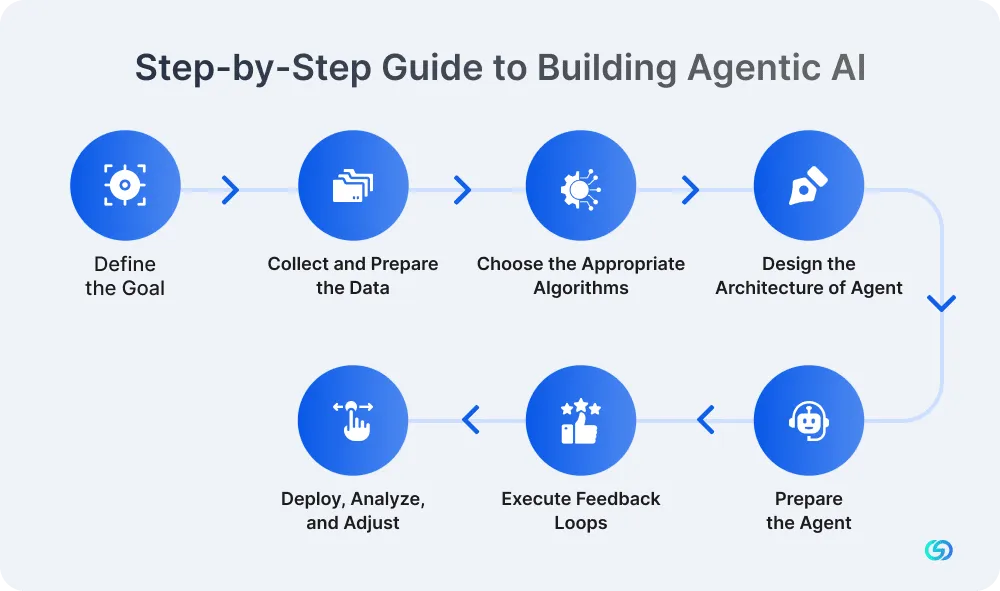
Building an Agentic AI system involves executing reasoning, perception, and action into a unified pipeline. Define the problem, use the right tool, and follow the steps to develop Agentic AI, capable of autonomously solving real challenges.
1. Define the Goal
- Be specific about what your agents wish to accomplish
- Define outputs, inputs, constraints, and success metrics
2. Collect and Prepare the Data
- Gather relevant, high-quality, and diverse datasets
- Label, clean, and structure the data for training
- Examine bias, missing context, and duplication. Avoid feeding it junk.
3. Choose the Appropriate Algorithms
- Leverage deep learning for complex-heavy tasks like language or vision
- Apply RL for environments where decisions affect future results
- When reasoning under unreliability, utilize Bayesian models
- Go hybrid if needed; most real-world systems already are
4. Design the Architecture of an Agent
- Break into different functional layers: reasoning, perception, memory, action, and evaluation.
- Prioritize modularity to update one part without interrupting the rest
- Test before sending it out
5. Prepare the Agent
- Use controlled environments before launching
- Examine learning behavior
- RL isn’t set-and-forget; you are coaching it.
6. Execute Feedback Loops
- Build a system for self-improvement and reflection
- Assess metrics, adjust rewards, and correct protocols
- Trace the errors and train the agent to recover the next time
7. Deploy, Analyze, and Adjust
- Begin small with a controlled environment and clear boundaries
- Real-time monitoring, fallback systems, and notifications
- For high-risk decisions, keep a human in the loop
- Constantly try to iterate
Challenges and Limitations of Agentic AI
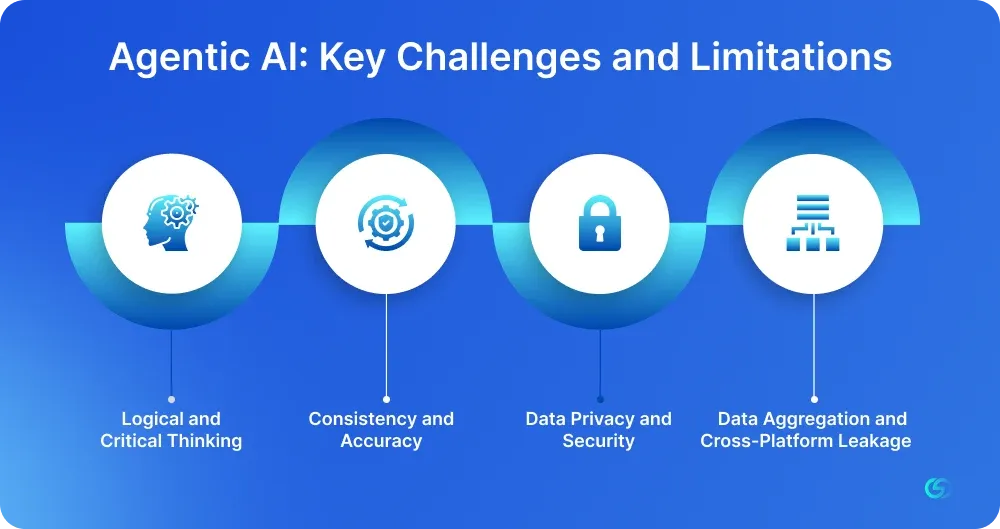
Gartner predicts that at least 15% of everyday work decisions will be made autonomously by Agentic AI by 2028, which will be up from 0% in 2024.
AI agents do solve complex problems, improve efficiency, save expenses, and free employees to strategize on more crucial projects, but they do come without limitations. Businesses need to be prepared to address a few issues when it comes to Agentic AI:
⏭ Logical and Critical Thinking
Agentic AI carries out the actions of multiple agents. The model offers a critical thinking function, which provides feedback on the planner and various agents fulfilling those instructions. The more feedback the model receives, the more it learns, leading to more accurate output.
For the system to work well, the critical thinking model needs to be as close to reality as possible. This means you need to give more information on particular goals, plans, and results. This may require multiple iterations before it has enough data to act as a critical thinker.
⏭ Consistency and Accuracy
When building a software system, an expert writes code and tells the machine to do exactly what it's supposed to do, step-by-step. With Agentic AI, you don’t have to offer phased instructions; instead, focus on the output you need to achieve, and the agent determines how to reach this target.
Autonomy in the agent’s behavior can lead to a slight unpredictability in results. A similar problem was faced with the coming of ChatGPT and other systems. However, in the past few years, we have seen some good improvements in their consistency. Similar effort is required to reduce the randomness of the system.
⏭ Data Privacy and Security
Many businesses are hesitant about Agentic AI applications in terms of privacy and security, similar to those of Generative AI. For instance, every piece of information given to the LLM model becomes embedded in it. You simply cannot ask to erase that detail. Prompt injection, a type of security attack, takes advantage of this by getting the model's proprietary information. With broad system access and high autonomy, software agents pose a heightened risk of exposing sensitive data across different platforms.
⏭ Data Aggregation and Cross-Platform Leakage
Designed to gather and blend information from various sources, Agentic AI gains a comprehensive understanding of its environment. This aggregation is beneficial for optimizing ad expenditures; however, this can lead to unforeseen security risks. For instance, data aggregated from various platforms could accidentally be exposed, even if single sources looked secure in isolation. Additionally, crucial data stored in silos might be revealed when combined and analyzed by an AI agent.
Ethical Considerations of Agentic AI System
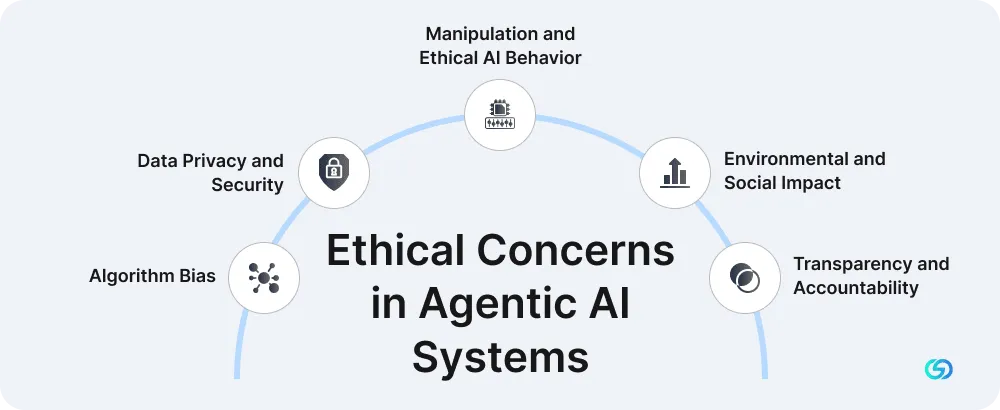
Ethics in Agentic AI means guidelines and principles that assess the moral behavior of the systems. As the Agentic AI systems become advanced and autonomous, they also raise important ethical questions. The most significant ethical challenge is ensuring clarity in the strategic planning process. These aren’t just theoretical concerns, but directly affect how safe, fair, and trustworthy these systems actually are in the real-world.
⏭ Algorithm Bias
Algorithm bias happens when AI systems incline or discriminate against certain groups based on the data that they have fetched. Agentic AI relies on previous data, so any embedded bias could be intensified. Think of a recruitment tool. If the system is trained on historical data with biases against specific demographics, autonomous AI could discriminate against qualified candidates. This bias raises ethical concerns, sometimes leading to legal issues and reputation damage.
⏭ Data Privacy and Security
Agentic AI has access to multiple systems, vast amounts of data, and large volumes of sensitive data. As these systems access and analyze this data, safeguarding privacy becomes important. Ensuring stringent data protection measures is crucial to avoid breaches. Think of a healthcare Agentic AI handling a patient record. Without strong security, crucial patient details could be exposed, violating trust. Ethical AI needs to ensure data protection at each stage and prioritize privacy standards.
⏭ Manipulation and Ethical AI Behavior
AI can influence smart strategies and decision-making, but should they be allowed to do that? AI systems can create fake videos or information to spread false information and attract people to buy things they don't actually need. To mitigate this risk, AI needs to be developed on well-defined ethical guidelines that ensure honesty, transparency, and respect for users. Businesses need to develop AI that focuses on fair practices, rather than deceiving them, and giving them control over their decisions.
⏭ Environmental and Social Impact
The impact of AI is transforming the world, and not being cautious can come with hidden costs. The large-scale data centers that run AI systems utilize a huge amount of electricity, resulting in more carbon emissions, which puts stress on the environment. To avoid this, businesses must opt for energy-efficient AI models that put human-AI collaboration at the forefront and implement ethical guidelines to ensure accountability and inclusiveness.
When it comes to the future of Agentic AI, it isn’t just limited to intelligence but also deploying it responsibly without compromising the environment and societal well-being.
⏭ Transparency and Accountability
As AI systems gain more autonomy, ensuring transparency and accountability becomes increasingly important. When these systems take on roles that affect businesses, consumers, or public services, their decisions must be understandable and traceable. However, as the underlying algorithms become more complex, the decision-making process can turn into a black box, difficult for users, developers, or regulators to interpret. This lack of visibility makes it harder to audit outcomes and identify bias. Without clear accountability, it becomes challenging to assign responsibility in cases of failure or harm.
Real-World Use Cases of Agentic AI
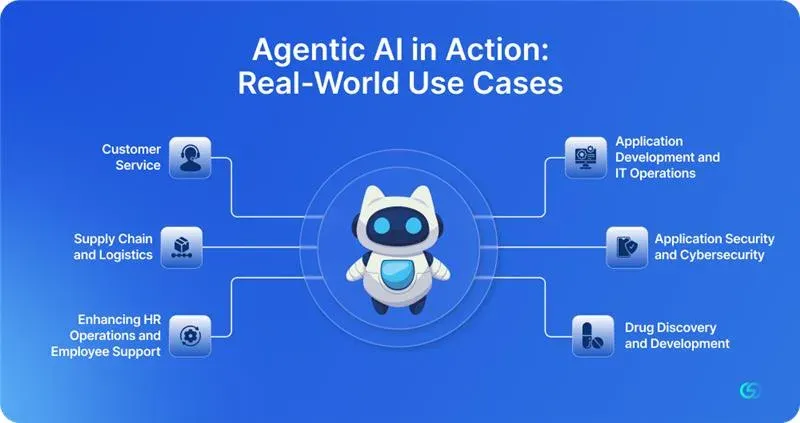
Agentic AI caters to multiple industries and use cases, driving smart decisions, autonomously handling complex workflows, and refining processes.
Customer Service
Agentic AI in customer service offers a lot of benefits, including 24/7 availability, cost reduction, enhanced productivity and efficiency, and improved customer experience. The system goes far beyond chatbots; it can handle the entire workflow, right from understanding customer problems, finding solutions, escalating when needed, and even follow-ups. These agents pull data from the system to offer accurate and personalized responses in real-time.
Application Development and IT Operations
Agentic AI can innovate the software lifecycle by upgrading the way software is developed, deployed, and maintained. About 4 out of 5 developers predict AI agents will become significant to app development.
These agents can help in producing large chunks of code and offer real-time suggestions. It can automate software testing as well by creating test cases and monitoring outcomes. These tasks can quicken the development process, reduce coding errors, and free up experts.
Supply Chain and Logistics
This is a sector where timing, efficiency, and coordination are everything. Agentic AI is transforming supply chain and logistics management with real-time decisions that adapt to changing conditions, delays, and demands. Agentic AI makes an impact with dynamic route optimization, inventory management, demand forecasting, and coordinating with the supplier. It allows businesses to respond to disruptions while enhancing transparency.
Application Security and Cybersecurity
Cyber threats are growing in numbers—in 2024, about 30,000 vulnerabilities were discovered, highlighting a 17% YOY increase. In such cases, Agentic AI plays a crucial role, proving to be a critical ally to strengthen security by overcoming traditional tools like antivirus software and firewalls.
Agentic AI comes with a strong threat detection system to analyze factors like network congestion, app code, user behavior, and system logs. This decreases the chance of attacking.
Enhancing HR Operations and Employee Support
HR operations and employee support are significantly enhanced with the help of Agentic AI by automating repetitive tasks, offering personalized employee experiences, and decision-making within the HR department. This advanced technology can handle a range of HR functions, benefiting administration and performance management.
Drug Discovery and Development
With the help of Agentic AI, the time-consuming process of drug discovery and development can shrink, bringing treatments quickly to patients. AI systems can stimulate target identification and predict therapeutic outcomes with unparalleled precision. The AI agents integrate with large datasets from genomics, clinical research, and chemical libraries, leading to smart decision-making and decreasing time-to-market for important medicines.
Future of Agentic AI
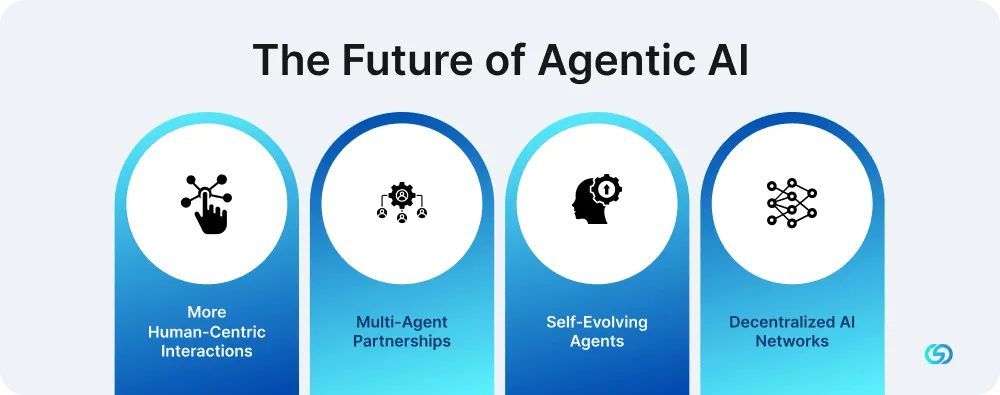
The race to develop autonomous systems has accelerated with the development of Agentic AI, a game-changing evolution. These systems are reshaping multiple industries and redefining modern work. Experts are working toward making Agentic AI systems more reliable and robust, capable of operating safely in complex environments. And this is what the future holds:
🔵 More Human-Centric Interactions
Agentic AI will slowly incline toward understanding human context, intent, and emotion deeply, leading to interactions that feel intuitive, natural, and supportive.
🔵 Multi-Agent Partnerships
The future systems of Agentic AI will consist of several agents working collaboratively with each specializing in different tasks, solving complex issues. You can take them as a digital team managing everything from operations to emergency response.
🔵 Self-Evolving Agents
In the future, intelligent agents will be able to learn new skills, adapt their roles based on changing goals, and receive feedback without the need to be reprogrammed.
🔵 Decentralized AI Networks
Instead of relying only on massive, centralized data centers, we may see more decentralized agents that work closer to where data is generated, improving speed, privacy, and sustainability.
Frequently Asked Questions
What Makes AI “Agentic”?
Agentic AI refers to a system that functions with autonomy, reasoning, memory, and goal-oriented behavior. Compared to traditional automation, Agentic AI agents can set goals, plan steps, adapt to feedback and take initiatives, like a human agent would.
How Does Agentic AI Differ from Generative AI?
Generative AI focuses on crafting new text, videos, code, and more, while Agentic AI is developed to act. It does more than just generate content; it plans, reasons, decides, and executes the work in sequence based on a defined objective. Generative AI models like GPT can fuel Agentic AI agents; however, they are only a component, not the entire system.
How Safe is it to Use Agentic AI in Critical Systems?
To understand the safety of using Agentic AI in critical systems depends on how it is implemented. An Agentic AI introduces efficiency and autonomy, raising risks like unintended behavior, lack of explainability, and bias. This is why human oversight, clear boundaries, and fail-safes are important when deploying Agentic AI in a high-stakes environment.
Who Should Consider Implementing Agentic AI?
Businesses with repetitive processes, like customer support, logistics, automation, and scheduling, can benefit the most. From startups, SaaS platforms, and enterprise teams to process-heavy industries, these early adopters of Agentic AI are drawn to it due to its efficiency and scalability.
How Can Agentic AI Handle Unexpected Scenarios or Errors?
Using feedback loops and context awareness helps Agentic AI to handle unexpected outcomes. It tracks if actions lead to desired outcomes and, if not, it re-evaluates the plan. However, the reliability of the system depends on how well its decision boundaries and fallback mechanisms are designed.
Apart from Enterprises, Can Small Businesses Benefit from Agentic AI?
Yes, small and medium-sized businesses can benefit from Agentic AI, especially in task automation, lead nurturing, personalized communication, and internal workflow management. Many no-code and low-code tools support developing agentic flow with little technical support.
Can Agentic AI Replace Human Decision-Makers?
No, Agentic AI is designed in such a way as to augment and not replace human decision-makers. Agentic AI excels at repeatable, structured, and goal-driven tasks. However, it lacks common sense, emotional intelligence, and ethical reasoning. The best way is to use it as a co-pilot, not as a complete replacement.
How Does Agentic AI differ from Rule-Based Automation or RPA?
RPA follows static rules and can’t adapt to evolving input. The Agentic AI system is autonomous and adaptive; it is capable of reasoning, learning, and re-planning based on new information. You can think of it as a shift from “if-this-then-that" logic to a more advanced "understand, decide, and act" intelligence.
What is the Future of Agentic AI in Enterprise Ecosystems?
Agentic AI will become an important layer in enterprise tech stacks, acting as:
- A workflow coordinator
- A digital operations partner
- A cross-platform decision engine
Is It Possible to Use Agentic AI with APIs and External Tools?
Yes, it is. Most modern agentic systems are built to interact with databases, APIs, CRMs, third-party tools, and IoT systems. They can act as the decision layer between the tools you already use and business logic.

